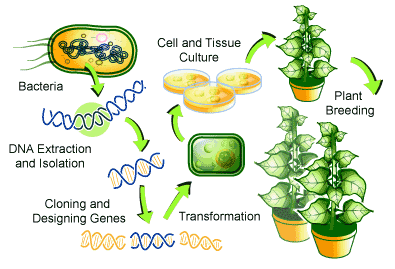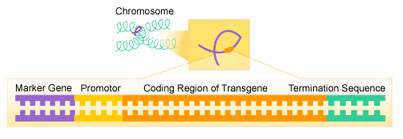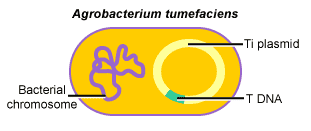TRANSGENIC CROPS: HOW GENETICS IS PROVIDING NEW WAYS TO ENVISION AGRICULTURE
(August 2003)
Even before the creation of transgenics, the alteration of crops to improve their production was performed through selection. In fact, this selection has been going on for thousands of years and only in the past few centuries has it become a dedicated science onto itself. So, why has there been a push to switch from selection to the use of genetic techniques (transgenics) to improve crops over the recent decades? Simply put, to manipulate plants through selection takes many generations (i.e. large investments of time) and does not always work. Through the use of transgenics, one can produce plants with desired traits and even increase yields to allow for more crops that last longer and withstand pests and disease. The idea being that we could produce the traits we want without throwing the dice as with selection techniques, allowing us to better feed a growing population and produce more desirable products. That’s the idea at least, but how exactly is it done? And should it be tried at all?
What is a Transgenic Crop?
A transgenic crop is a genetically modified organism (GMO). Transgenic indicates that a transfer of genes has occurred using recombinant DNA technology [1]. Generally a transgenic crop contains one or more genes that have been inserted artificially either from an unrelated plant or from different species altogether.
Why do we use Transgenic Crops?
Plants have been modified for many reasons over the years but the most common purpose is to produce the best products possible. Before recombinant DNA technology, it was possible to produce some improved products, although it was very difficult to do and many things could not be improved or changed. An improved product may involve changing the color or the size of a plant, making it more appealing to the buyer’s eye. Or it may be more practical, allowing increased tolerance to cold, frost, or drought; all making a crop easier to grow in a constantly changing environment [4]. Goals like these are unattainable with traditional selection programs and thus transgenics is now preferred when trying to come up with new products to improve sales. One of the hottest areas right now is the modification of crops to increase the resistance of plants to insects and diseases they may carry [1]. Improving resistance to these diseases and insects also reduces the need for herbicides and pesticides. This makes the plants safer for the consumer and allows the farmer to save money on chemicals. In conclusion, transgenic crops are an economically safer method of producing crop products, which makes them appealing and potentially profitable.
How are Transgenic Crops Made?
For many years plant breeding entailed the selection of the finest plants to get the best crops. In those days, variation occurred through induced mutation or hybridization where two or more plants were crossed. Selection occurred through nature, using a “selection of the fittest” concept, where only the seeds best adapted to that environment succeeded. For example, farmers selected only the biggest seeds with non-shattering seed heads, assuming these to be the best. Today, scientists can not only select, but also create crops by inserting genes to make a seeds bare any trait desired.
In order to make a transgenic crop, there are five main steps: extracting DNA, cloning a gene of interest, designing the gene for plant infiltration, transformation, and finally plant breeding (see Figure 1).

To understand this process, one must first known a bit about DNA (deoxyribonucleic acids). DNA is the universal programming language of all cells and stores their genetic information. It contains thousands of genes, which are discrete segments of DNA that encode the information necessary to produce and assemble specific proteins. All genes require specific regions in order to be utilized (or expressed) by a cell. These regions include (see Figure 2):
1. A promoter region, which signals where a gene begins and it used to express the gene;
2. A termination sequence, which signals the end of a gene;
3. And the coding region, which contains the actual gene to be expressed.
All these regions together allow a gene to create a protein. Once a gene is transcribed into a protein, it can then function as an enzyme to catalyze biochemical reactions or as a structural unit of a cell, both of which will contribute to the appearance of a particular trait in that organism.

All species are capable of turning DNA into protein through a process known as translation. This capability makes it possible to artificially put genes from one organism into another-a process generally termed transgenics. But just isolating random DNA and inserting it into another organism is not practical. We must first know what particular segments of DNA, and in particular what genes, to insert. Unfortunately, with reference to producing new crops, not much is known about which genes are responsible for increased plant yield, tolerance to different stresses and insects, color, or various other plant characteristics. Much of the research in transgenics is now focused on how to identify and sequence genes contributing to these characteristics.
Genes that are determined to contribute to certain traits then need to be obtained in a significant amount before they can be inserted into another organism. In order to obtain the DNA comprising a gene, DNA is first extracted from cells and put into a bacterial plasmid. A plasmid is a molecular biological tool that allows any segment of DNA in be put into a carrier cell (usually a bacterial cell) and replicated to produce more of it. A bacterial cell (i.e. E. coli) that contains a plasmid can put aside and used over and over again to produce copies of the gene the researcher is interested in, a process that is generally referred to as “cloning” the gene. The word “cloning” referring to how many identical copies of the original gene can now be produced at will. Plasmids containing this gene can be used to modify the gene in any way the researcher sees fit, allowing novel effects on the gene trait to be produced (see Figure 1).
Once the gene of interest has been amplified, it is time to introduce it into the plant species we are interested in. The nucleus of the plant cell is the target for the new transgenic DNA. There are many methods of doing this but the two most common methods include the “Gene Gun” and Agrobacterium method.
The “Gene Gun” method, also known as the micro-projectile bombardment method, is most commonly used in species such as corn and rice. As its name implies, this procedure involves high velocity micro-projectiles to deliver DNA into living cells using a gun [1]. It involves sticking DNA to small micro-projectiles and then firing these into a cell. This technique is clean and safe. It enables scientists to transform organized tissue of plant species and has a universal delivery system common to many tissue types from many different species1. It can give rise to un-wanted side effects, such as the gene of interest being rearranged upon entry [1] or the target cell sustaining damage upon bombardment. Nevertheless, it has been quite useful for getting transgenes into organisms when no other options are available.
The Agrobacterium method involves the use of a soil-dwelling bacteria known as Agrobacterium tumefaciens, which has the ability to infect plant cells with a piece of its DNA. The piece of DNA that infects a plant is integrated into a plants chromosome through a tumor-inducing plasmid (Ti plasmid), which can take control of the plant’s cellular machinery and use it to make many copies of its own bacterial DNA. The Ti plasmid is a large circular DNA particle that replicates independently of the bacterial chromosome [1] (see Figure 3).

The importance of this plasmid is that it contains regions of transfer DNA (tDNA), where a researcher can insert a gene, which can be transferred to a plant cell through a process known as a floral dip. A floral dip involves dipping flowering plants into a solution of Agrobacterium carrying the gene of interest, followed by the transgenic seeds being collected directly from the plant [1]. This process is useful in that it is a natural method of transfer and therefore thought of as a more acceptable technique. In addition, Agrobacterium is capable of transferring large fragments of DNA very efficiently without substantial rearrangements, followed by maintaining high stability of the gene that was transferred [1]. One of the biggest limitations of Agrobacterium is that not all important food crops can be infected by this bacteria [1].
What are the Advantages and Disadvantages of Transgenic Crops?
The use of transgenic crops has been an issue for many years. Many concerns have been raised and these generally fall into two categories:
1.A concern about what affect genetically modified material could have on human health. For example, transgenic crops have been suggested to cause allergies in some people, although it is uncertain whether transgenic crops are the source of this reaction [3]. Furthermore the antibiotic resistance genes placed in these crops has been suggested to cause resistance to antibiotics leading to super bugs that cannot be killed with antibiotic treatments [3]. The idea of a population being uncomfortable with ingesting DNA that originated from another source, such as a virus or bacteria, must also be considered when thinking about producing transgenic crops. However, to date, there is no evidence of the DNA from transgenic crops being any different from the DNA ingested from conventional crops.
2. A concern about whether transgenic crops cause damage to the natural environment. One example includes pollen from transgenic corn, which has been suggested to kill the Monarch butterfly larvae. It has been shown that hybrid corn expresses a bacterial toxin in its pollen, which is then dispersed over 60 meters by wind. In this range, the corn pollen is deposited on other plants near cornfields where it can be ingested by non-target organisms including the monarch butterfly [5]. These butterflies have been found to eat less, have a slower growth rate and higher death rate [5]. A second example is the hybridization of crops with nearby weeds. This could cause these weeds to attain resistance to herbicides or other things that we have been trying to avoid for many years. Genes that provide resistance to viral disease or other traits allowing them to survive in their environment could end up benefiting weed populations around a crop field. This trait could make that population more difficult to control. To date, there has been little evidence to support this theory[2].
On other side of the coin are the notions that support the use of transgenic crops. The potential benefits of which are quite obvious, including such things as increased yields (to feed a growing population), decreasing the use of pesticides (to save the environment and the cost of pesticides), and the production of novel crops (such as providing crops with increased nutritional value) [3]. Being able to retrofit any crop to our desires is a powerful concept, especially with the changing climates of today.
Should We Use Transgenic Crops?
In the end, the perceived advantages and disadvantages of transgenic crops must be married to each other to provide a crop that is environmentally sound and non-hazardous. Producers of transgenic crops and the agencies that study their effects are aware of this point. However, to date, there has been little evidence to support either case. More research is required in this field to determine the true safety of these plants and to decide whether they are safe for both the environment and for those who consume these products over the ages. At the least, most would agree that the potential advantage of producing crops that provide the human population with more and cheaper food makes transgenic technology a useful invention.
Additional Reading and Texts Consulted
1. Colorado State University. 2002. Transgenic Crops: An introduction and resource guide.
2. Animation of the process of cloning genes
3. Animation of how a gene gun works
4. Buchanan B. 2001. Genetic engineering and the allergy issue. Plant Physiology 126:5-7.
References
1. Chawla HS. 2000. Introduction to Plant Biotechnology. Enfield, NH, USA: Science Publishers Inc.
2. Crawley MJ, Brown SL, Hails RS, Kohn DD, Rees M. 2001. Transgenic crops in natural habitats. Nature 409: 682-3.
3. Ferber D. 1999. Risks and benefits: GM crops in the cross hairs. Science 286: 1662-6.
4. Gasser CS, Fraley RT. 1989. Genetically engineered plants for crop improvement. Science 244(4910): 1293-9.
5. Losey JE, Rayor LS, Carter ME. 1999. Transgenic pollen harms monarch larvae. Nature 399(6733): 214.
(Art by Jane Wang – note that high res versions of these image files are available here)